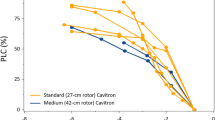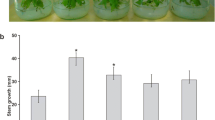Abstract
Key message
Ray parenchyma cells represent the main pathway for mineral radial movement from sapwood towards intermediate wood, based on direct cryo-scanning electron microscopy/energy dispersive X-ray spectroscopy analysis.
Abstract
Ray parenchyma cells are considered to be associated with the radial movement of some elements from sapwood to heartwood in tree trunks. However, this function has not yet been experimentally confirmed. In this study, we analysed the radial movement of caesium (Cs), as a tracer of minerals, through the xylem at the cellular level in standing trees. A solution containing a stable Cs isotope diluted in aqueous acid fuchsin was injected into the outer sapwood of Japanese cedar trees for 3 h, 1, or 4 days. After the injection, the trunk (including the injection points) was freeze-fixed with liquid nitrogen. Subsequently, the trees were felled. The red colour from acid fuchsin was detected in the outer sapwood and did not move passively in the radial direction with free water. For detailed analysis of the Cs distribution in the radial direction (from the red-coloured sapwood towards the pith), we performed cryo-scanning electron microscopy/energy-dispersive X-ray spectroscopy point analysis of the frozen-hydrated samples to analyse the Cs distribution by detecting the characteristic Cs-Lα X-ray peak. In the outer sapwood, Cs was detected in all cell structures at all injection periods. In the inner xylem tissue, Cs was detected in the cell wall and lumen of ray parenchyma cells at 4-day injection, but not at 3-h and 1-day injection. These results suggest that ray parenchyma cells represent the main pathway whereby Cs can move radially from sapwood towards intermediate wood in standing Japanese cedar trees.








Similar content being viewed by others
References
Barnard DM, Lachenbruch B, McCulloh KA, Kitin P, Meinzer FC (2013) Do ray cells provide a pathway for radial water movement in the stems of conifer trees? Am J Bot 100:322–331
Chaffey N, Barlow P (2001) The cytoskeleton facilitates a three-dimensional symplasmic continuum in the long-lived ray and axial parenchyma cells of angiosperm trees. Planta 213:811–823
Chaffey N, Barnet J, Barlow P (1999) A cytoskeletal basis for wood formation in angiosperm trees: the involvement of cortical microtubules. Planta 208:19–30
Chaffey N, Barlow P, Barnet J (2000) A cytoskeletal basis for wood formation in angiosperm trees: the involvement of microfilaments. Planta 210:890–896
Funada R (2000) Control of wood structure. In: Nick P (ed) Plant microtubules potential for biotechnology. Springer, Berlin, Heidelberg, pp 51–81
Funada R, Yamagishi Y, Begum S et al (2016) Xylogenesis in trees: from cambial cell division to cell death. In: Kim YS, Funada R, Singh AP (eds) Secondary xylem biology: origins, functions, and applications. Academic press, Amsterdam, pp 25–43
Kagawa A, Aoki T, Okada N, Katayama Y (2002) Tree-ring strontium-90 and cesium-137 as potential indicators of radioactive pollution. J Environ Qual 31:2001–2007
Katayama Y, Okada N, Ishimaru Y, Nobuchi T, Yamashita H, Aoki A (1986a) Determination of trace elements in annual rings of Yaku Sugi by the thermal neutron activation analysis. (in Japanese with English summary and figure legends). Radioisotopes 35:577–582
Katayama Y, Okada N, Ishimaru Y, Nobuchi T, Aoki A (1986b) Behavior of radioactive nuclides on the radial direction of the annual ring of Sugi. (in Japanese with English summary and figure legends). Radioisotopes 35:636–638
Komatsu M, Kaneko S, Ohashi S et al (2016) Characteristics of initial deposition and behavior of radiocesium in forest ecosystems of different locations and species affected by the Fukushima Daiichi Nuclear Power Plant accident. J Environ Radioact 161:2–10
Kordan HA (1987) Reversal of caesium inhibition of growth by potassium in hypocotyls of tomato seedlings (Lycopersicon esculentum L.). New Phytol 107:395–401
Kudo K, Yasue K, Hosoo Y, Funada R (2015) Relationship between formation of earlywood vessels and leaf phenology in two ring-porous hardwoods, Quercus serrata and Robinia pseudoacacia, in early spring. J Wood Sci 61:455–464
Kuroda K, Ohtani J, Kubota M, Fujikawa S (1999) Seasonal changes in the freezing behavior of xylem ray parenchyma cells in four boreal hardwood species. Cryobiology 23:1163–1172
Kuroda K, Kasuga J, Arakawa K, Fujikawa S (2003) Xylem ray parenchyma cells in boreal hardwood species respond to subfreezing temperatures by deep supercooling that is accompanied by incomplete desiccation. Plant Physiol 131:736–744
Kuroda K, Yamashita K, Fujiwara T (2009) Cellular level observation of water loss and the refilling of tracheids in the xylem of Cryptomeria japonica during heartwood formation. Trees 23:1163–1172
Kuroda K, Fujiwara T, Imai T et al (2013a) The cryo-TOF-SIMS/SEM system for the analysis of the chemical distribution in freeze-fixed Cryptomeria japonica wood. Surf Interface Anal 45:215–219
Kuroda K, Kagawa A, Tonosaki M (2013b) Radiocesium concentrations in the bark, sapwood and heartwood of three tree species collected at Fukushima forests half a year after the Fukushima Dai-ichi nuclear accident. J Environ Radioact 122:37–42
Kuroda K, Fujiwara T, Hashida K et al. (2014) The accumulation pattern of ferruginol in the heartwood-forming Cryptomeria japonica xylem as determined by time-of-flight secondary ion mass spectrometry and quantity analysis. Ann Bot 113:1029–1036
Magel EA (2000) Biochemistry and physiology of heartwood formation. In: Savidge RA, Barnett JR, Napier R (eds) Cell and molecular biology of wood formation. Experimental biology reviews. BIOS Scientific Publishers, Oxford, pp 363–376
McCully ME, Canny MJ, Huang CX (2009) Cryo-scanning electron microscopy (CSEM) in the advancement of functional plant biology. Morphological and anatomical applications. Funct Plant Biol 36:97–124
McCully ME, Canny MJ, Huang CX, Miller C, Brink F (2010) Cryo-scanning electron microscopy (CSEM) in the advancement of functional plant biology: energy dispersive X-ray microanalysis (CEDX). Funct Plant Biol 37:1011–1040
Ministry of Agriculture, Forestry and Fisheries (MAFF) (2017) Results of the survey on the distribution of radioactive materials in the forest in FY2016. http://www.rinya.maff.go.jp/j/kaihatu/jyosen/H28_jittaihaaku_kekka.html (in Japanese, 28 June 2017)
Nagasaki T, Yasuda S, Imai T (2002) Immunohistochemical localization of agatharesinol, a heartwood norlignan, in Cryptomeria japonica. Phytochemistry 60:461–466
Nakaba S, Kubo T, Funada R (2008) Differences in patterns of cell death between ray parenchyma cells and ray tracheids in the conifers Pinus densiflora and Pinus rigida. Trees 22:623–630
Nakaba S, Arakawa I, Morimoto H et al (2016a) Agatharesinol biosynthesis-related changes of ray parenchyma in sapwood sticks of Cryptomeria japonica during cell death. Planta 243:1125–1236
Nakaba S, Hirai A, Kudo K et al (2016b) Cavitation of intercellular spaces is critical to establishment of hydraulic properties of compression wood of Chamaecyparis obtusa seedlings. Ann Bot 117:457–463
Nakaba S, Morimoto H, Arakawa I, Yamagishi Y, Nakada R, Funada R (2017) Responses of ray parenchyma cells to wounding differ between earlywood and latewood in the sapwood of Cryptomeria japonica. Trees 31:27–39
Nakada R, Fukatsu E (2012) Seasonal variation of heartwood formation in Larix kaempferi. Tree Physiol 32:1497–1508
Nakada R, Fujisawa Y, Hirakawa Y (1999) Soft X-ray observation of water distribution in the stem of Cryptomeria japonica D. Don. I: general description of water distribution. J Wood Sci 45:188–193
Nobuchi T, Harada H (1983) Physiological features of the ‘white zone’ of sugi (Cryptomeria japonica D. Don) -cytological structure and moisture content. Mokuzai Gakkaishi 29:824–832
Ohashi S, Kuroda K, Takano T et al (2017) Temporal trends in 137Cs concentrations in the bark, sapwood, heartwood, and whole wood of four tree species in Japanese forests from 2011 to 2016. J Environ Radioact 178–179:335–342
Okada N, Katayama Y, Nobuchi T, Ishimaru Y, Yamashita H, Aoki A (1987) Trace elements in the stems of trees, 1: radial distribution in sugi (Cryptomeria japonica D. Don). Mokuzai Gakkaishi 33:913–920
Okada N, Hirakawa Y, Katayama Y (2011) Application of activable tracers to investigate radial movement of minerals in the stem of Japanese cedar (Cryptomeria japonica). J Wood Sci 57:421–428
Okada N, Hirakawa Y, Katayama Y (2012) Radial movement of sapwood-injected rubidium into heartwood of Japanese cedar (Cryptomeria japonica) in the growing period. J Wood Sci 58:1–8
Pfautsch S, Renard J, Tjoelker MG, Salih A (2015) Phloem as capacitor: radial transfer of water into xylem of tree stems occurs via symplastic transport in ray parenchyma. Plant Physiol 167:963–971
Plavcová L, Jansen S (2015) Symplasmic transport in wood: the importance of living xylem cells symplasmic transport in vascular plants. In: Hacke U (ed) Functional and ecological xylem anatomy. Springer International Publishing, Cham, pp 209–234
Sano Y, Okamura Y, Utsumi Y (2005) Visualizing water-conduction pathways of living trees: selection of dyes and tissue preparation methods. Tree Physiol 25:269–275
Sauter JJ, Kloth S (1986) Plasmodesmatal frequency and radial translocation rates in ray cells of poplar (Populus × canadensis Moench ‘robusta’). Planta 168:377–380
Sauter JJ, Cleve B van (1991) Biochemical and ultrastructural results during starch-sugar-conversion in ray parenchyma cells of Populus during cold adaptation. J Plant Physiol 139:19–26
Sauter JJ, Cleve B van (1994) Storage, mobilization and interrelations of starch, sugars, protein and fat in the ray storage tissue of poplar trees. Trees 8:297–304
Sokołowska K (2013) Symplasmic transport in wood: the importance of living xylem cells symplasmic transport in vascular plants. In: Sokołowska K, Sowiński P (eds) Symplasmic transport in vascular plants. Springer, New York, pp 101–132
Sokołowska K, Zagórska-Marek B (2012) Symplasmic, long-distance transport in xylem and cambial regions in branches of Acer pseudoplatanus (Aceraceae) and Populus tremula × P. tremuloides (Salicaceae). Am J Bot 99:1745–1755
Spicer R (2014) Symplasmic networks in secondary vascular tissues: parenchyma distribution and activity supporting long-distance transport. J Exp Bot 65:1829–1848
Takada J, Takamatsu T, Satake K, Sase H (1994) Data on elemental concentration in land plants by neutron activation analysis (no. 1). National Institute for Environmental Studies F-58-’93, PP260. https://www.nies.go.jp/kanko/gyomu/pdf/pdf/f058-1993.pdf (15 Feb 2017; in Japanese)
Umebayashi T, Utsumi Y, Koga S et al (2007) Optimal conditions for visualizing water-conducting pathways in a living tree by the dye injection method. Tree Physiol 27:993–999
Umebayashi T, Utsumi Y, Koga S et al (2008) Conducting pathways in north temperate deciduous broadleaved trees. IAWA J 29:247–263
Utsumi Y, Sano Y, Funada R, Ohtani J, Fujikawa S (2003) Seasonal and perennial changes in the distribution of water in the sapwood of conifers in a sub-frigid zone. Plant Physiol 131:1826–1833
van Bel AJE (1990) Xylem-phloem exchange via the rays: the undervalued route of transport. J Exp Bot 41:631–644
van der Schoot C, van Bel AJE (1990) Mapping membrane potential differences and dye-coupling in internodal tissues of tomato (Solanum lycopersicum L.). Planta 182:9–21
White PJ, Broadley MR (2000) Mechanisms of caesium uptake by plants. New Phytol 147:241–256
Yazaki K, Kuroda K, Nakano T et al (2015) Recovery of physiological traits in saplings of invasive Bischofia tree compared with three species native to the Bonin Islands under successive drought and irrigation cycles. PLoS One 10(8):e0135117. https://doi.org/10.1371/journal.pone.0135117
Acknowledgements
We thank Dr. Chunhua Zhang of Forestry and Forest Products Research Institute for assistance in sampling. This work was supported by Japan Society for the Promotion of Science, JSPS KAKENHI Grant Numbers 25292110, 16H04936, and 18H02258.
Author information
Authors and Affiliations
Corresponding author
Ethics declarations
Conflict of interest
The authors declare that they have no conflict of interest.
Additional information
Communicated by Magel.
Electronic supplementary material
Below is the link to the electronic supplementary material.
468_2018_1729_MOESM1_ESM.pptx
Online Resource 1 Representative SE images of the first and last scans and elemental mappings (C, O, and Cs) of a frozen-hydrated Japanese cedar xylem obtained by cryo-SEM/EDX. (a) Low-magnification image analysed for 2 h. (b) High-magnification image analysed for 10 min. Cs mapping failed because of the low Cs concentration. (c) High-magnification image analysed for 2 h. The cell wall structure was deformed during the analysis because of electron beam damage, indicating that Cs mapping contained artefacts. Arrowheads indicate the blank of the X-ray signal where the cell wall blocked the generated X-rays to the detector (PPTX 3840 KB)
Rights and permissions
About this article
Cite this article
Kuroda, K., Yamane, K. & Itoh, Y. Cellular level in planta analysis of radial movement of artificially injected caesium in Cryptomeria japonica xylem. Trees 32, 1505–1517 (2018). https://doi.org/10.1007/s00468-018-1729-5
Received:
Accepted:
Published:
Issue Date:
DOI: https://doi.org/10.1007/s00468-018-1729-5




